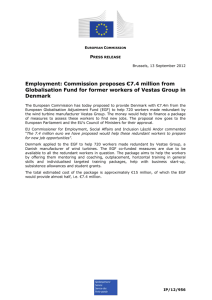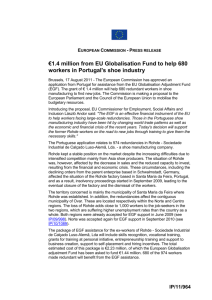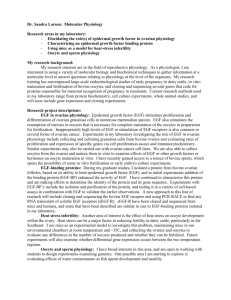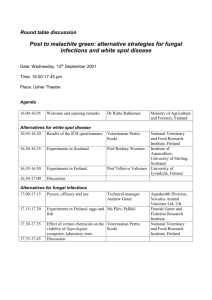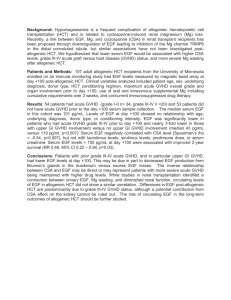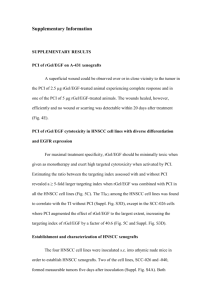context of the proposal
advertisement
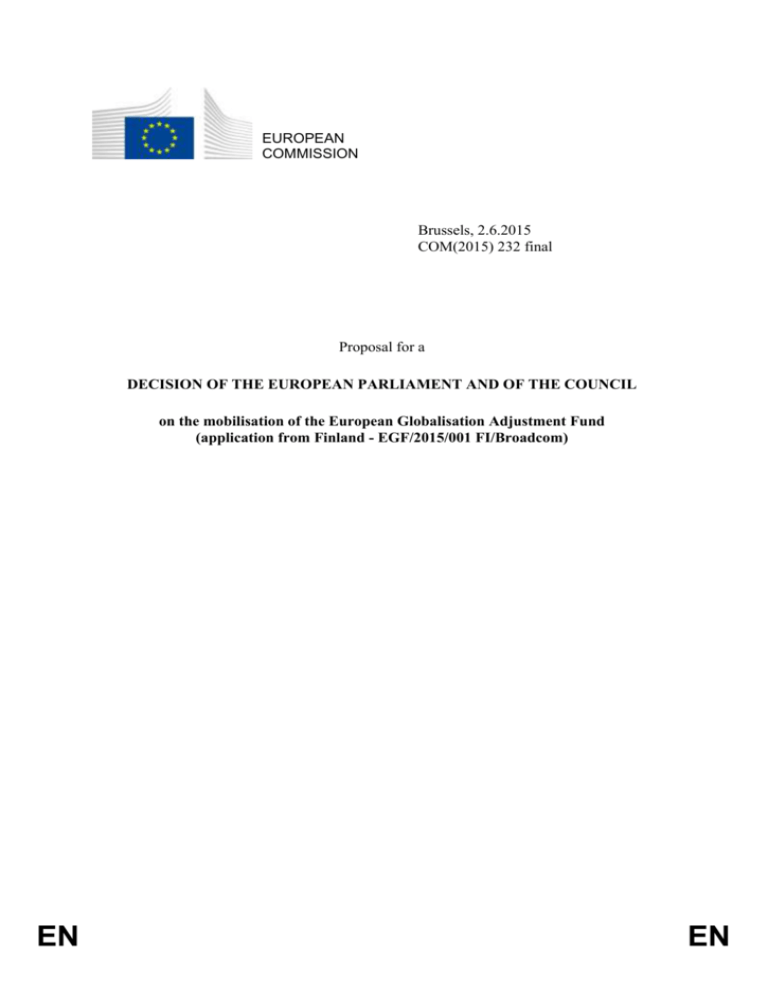
EUROPEAN COMMISSION Brussels, 2.6.2015 COM(2015) 232 final Proposal for a DECISION OF THE EUROPEAN PARLIAMENT AND OF THE COUNCIL on the mobilisation of the European Globalisation Adjustment Fund (application from Finland - EGF/2015/001 FI/Broadcom) EN EN EXPLANATORY MEMORANDUM CONTEXT OF THE PROPOSAL 1. The rules applicable to financial contributions from the European Globalisation Adjustment Fund (EGF) are laid down in Regulation (EU) No 1309/2013 of the European Parliament and of the Council of 17 December 2013 on the European Globalisation Adjustment Fund (2014-2020) and repealing Regulation (EC) No 1927/20061 (the 'EGF Regulation'). 2. On 30 January 2015, Finland submitted an application EGF/2015/001 FI/Broadcom for a financial contribution from the EGF, following redundancies2 in Broadcom Communications Finland and two suppliers or downstream producers in Finland. 3. Following its assessment of this application, the Commission has concluded, in accordance with all applicable provisions of the EGF Regulation, that the conditions for awarding a financial contribution from the EGF are met. SUMMARY OF THE APPLICATION EGF application EGF/2015/001 FI/Broadcom Member State Region(s) concerned (NUTS level 2) Finland All regions of Finland except Åland Date of submission of the application 30 January 2015 Date of acknowledgement of receipt of the application 13 February 2015 Date of request for additional information 13 February 2015 Deadline for provision of the additional information 27 March 2015 Deadline for the completion of the assessment 19 June 2015 Intervention criterion Article 4(1)(a) of the EGF Regulation Primary enterprise Broadcom Communications Finland Sector(s) of economic activity (NACE Revision 2 Division)3 Division 46 (Wholesale trade, except of motor vehicles and motorcycles) Number of subsidiaries, suppliers and downstream producers 2 Reference period (four months): 11 August 2014 - 11 December 2014 Number of redundancies (a) 568 Number of redundancies before or after the reference period (b) 0 Total number of redundancies (a + b) 568 1 2 3 EN OJ L 347, 20.12.2013, p. 855. Within the meaning of Article 3 of the EGF Regulation. Regulation (EC) No 1893/2006 of the European Parliament and of the Council of 20 December 2006 establishing the statistical classification of economic activities NACE Revision 2 and amending Council Regulation (EEC) No 3037/90 as well as certain EC regulations on specific statistical domains (OJ L 393, 30.12.2006, p. 1). 2 EN Total number of eligible targeted beneficiaries 568 Total number of targeted beneficiaries 500 Number of targeted young persons not in employment, education or training (NEETs) Budget for personalised services (EUR) Budget for implementing EGF4 (EUR) Total budget (EUR) EGF contribution (60 %) (EUR) 0 2 172 000 103 000 2 275 000 1 365 000 ASSESSMENT OF THE APPLICATION Procedure 4. On 30 January 2015, Finland submitted application EGF/2015/001 FI/Broadcom within 12 weeks of the date on which the intervention criteria set out in Article 4 of the EGF Regulation were met. The Commission acknowledged receipt of the application within two weeks of the date of submission of the application, on 13 February 2015, and requested additional information from Finland on the same date. Such additional information was provided within six weeks of the request. The deadline of 12 weeks of the receipt of the complete application within which the Commission should finalise its assessment of the application's compliance with the conditions for providing a financial contribution expires on 19 June 2015. Eligibility of the application Enterprises and beneficiaries concerned 5. The application relates to 568 workers made redundant in Broadcom Communications Finland and two suppliers or downstream producers. The primary enterprise operated in the economic sector classified under NACE Revision 2 Division 46 (Wholesale trade, except of motor vehicles and motorcycles). The redundancies made by the enterprises are located in all NUTS5 level 2 regions of Finland (except Åland), the most affected region being Northern Ostrobothnia (FI1A). Enterprises and number of dismissals within the reference period Broadcom Communications Finland Nice-Business Solutions Finland Infocare 563 4 1 Total no. of enterprises: 3 Total no. of dismissals: 568 Intervention criteria 6. 4 5 EN Finland submitted the application under the intervention criteria of Article 4(1)(a) of the EGF Regulation, which requires at least 500 workers being made redundant over a reference period of four months in an enterprise in a Member State, including workers made redundant by suppliers and downstream producers and / or selfemployed persons whose activity has ceased. In accordance with the fourth paragraph of Article 7 of Regulation (EU) No 1309/2013. Commission Regulation (EU) No 1046/2012 of 8 November 2012 implementing Regulation (EC) No 1059/2003 of the European Parliament and of the Council on the establishment of a common classification of territorial units for statistics (NUTS) as regards the transmission of the time series for the new regional breakdown (OJ L 310, 9.11.2012, p. 34). 3 EN 7. The reference period of four months for the application runs from 11 August 2014 to 11 December 2014. 8. The redundancies during the reference period are as follows: – 563 workers made redundant in Broadcom Communications Finland, – 5 workers made redundant in two suppliers or downstream producers of Broadcom. Calculation of redundancies and of cessation of activity 9. The redundancies during the reference period have been calculated as follows: – 563 from the date of the employer's individual notice to lay off or to terminate the contract of employment of the worker, – 5 from the date of the de facto termination of the contract of employment or its expiry. Eligible beneficiaries 10. The total number of eligible beneficiaries is therefore 568. Link between the redundancies and major structural changes in world trade patterns due to globalisation 11. In order to establish the link between the redundancies and major structural changes in world trade patterns due to globalisation, Finland argues that in 2005, it is estimated that chipset development (the area in which Broadcom Communications Finland was active) provided employment for some 5 000 people in Europe. While the number of product development personnel in the industry increased globally (particularly in Asia and in the USA), it had dropped steeply in Europe where, by 2014, only a few hundred people were left. 12. The development and sale of mobile phone chipsets is in the hands of a small number of companies, of which Qualcomm (USA) is by far the largest (with a market share of some 66 % in Q1/2014 according to Strategy Analytics6). The next largest companies are MediaTek in Taiwan, Spreadtrum in China and Marvell and Intel in the USA. 13. The redundancies at Broadcom are linked with the trend that affects the entire Finnish electronics industry and culminated in Nokia's announcement of large-scale redundancies in 2011. In 2012, Nokia first dismissed 1 000 people at its Salo plant (EGF/2012/006 FI/Nokia Salo), followed by another 3 700 at the end of 2012 and spring 2013 (EGF/2013/001 FI/Nokia). An extensive product development programme was terminated and a substantial number of jobs were cut. 14. In the early 2000s, personnel in the Finnish electronics and electrical industry based in Finland and in overseas subsidiaries showed a steady development, but from 2007, there was a marked change with numbers abroad increasing while the numbers in Finland began a steady decline. 15. 6 EN https://www.strategyanalytics.com/default.aspx?mod=pressreleaseviewer&a0=5482 4 EN Electronics and electrical industry personnel 180 000 160 000 140 000 120 000 100 000 80 000 60 000 40 000 20 000 0 1998 1999 2000 2001 2002 2003 2004 2005 2006 2007 2008 2009 2010 2011 2012 2013 2014 (30.6) Personnel in Finland Personnel in overseas subsidiaries Source: Statistics Finland, personnel survey for Technology Industries 16.1.2015 8 During the 2000s, personnel numbers in Finnish subsidiaries on all continents increased, then, from the year 2004, Asia emerged as clearly the greatest employer in the electronics and electrical industry. In Europe, personnel numbers continued to increase until 2008, after which they started declining. Electronics and electrical industry personnel in overseas subsidiaries 90,000 80,000 70,000 60,000 50,000 40,000 30,000 20,000 10,000 0 1998 1999 2000 2001 2002 2003 2004 2005 2006 2007 2008 2009 2010 2011 2012 2013 Western Europe Central and Eastern Europe Northern Africa Asia and Oceania Middle East and Africa Latin America Source: Statistics Finland, personnel survey for Technology Industries 16. EN 12.2.2015 9 To date, the NACE Revision 2 Division 46 (Wholesale trade, except of motor vehicles and motorcycles) has been the subject of two EGF applications (the other being EGF/2010/012 NL/Noord Holland ICT), both of which for ICT and based on trade related globalisation. 5 EN Events giving rise to the redundancies and cessation of activity 17. The event giving rise to the redundancies in Broadcom is the decision to wind down the company's cellular baseband business, a decision which affected 3 000 people globally, 600 of whom in Finland. Broadcom is closing down all its activities in Finland; the design of mobile chipsets is being delocalised by Broadcom and is set to continue in the United States and Asia. 18. In 2005, there were four major mobile phone chipset manufacturers in Europe. Nokia and Philips designed their own chipsets, Ericsson Mobile Platforms (EMP) mainly designed them for Sony-Ericsson, and Infineon produced them commercially for phone manufacturers. Nokia had been designing chipsets for its own phones from the 1980s on. The company did most of its own design, while the actual chipset production mainly took place at the works of Texas Instruments (TI) and STMicroelectronics (STM). Nokia decided to give up in-house chipset development in 2007 and sold its development units to STMicroelectronics. 19. At this stage, Nokia still kept the design of wireless modems in its own hands and licenced the results to chipset manufacturers, including STM. Nokia gave up modem design in 2010, in which year it sold these operations to the Japanese Renesas Mobile Corporation (RMC), a subsidiary of Renesas Electronics (REC). In connection with this deal, some 1 100 Nokia product designers moved over to a new employer. 20. Due to major long-term losses made by REC, a decision was made to wind down RMC in 2013. In the autumn of 2013, REC sold the LTE7 area of its modem business to Broadcom (BCM), and some 800 people previously employed by Renesas were now working for Broadcom. After only a few months, it was Broadcom's turn to announce that its entire Cellular Baseband business was to be wound down. At this stage, new buyers could no longer be found. Expected impact of the redundancies as regards the local, regional or national economy and employment 21. The redundancies have a significant adverse impact, particularly on the regional economy of Northern Ostrobothnia (part of the NUTS level 2 region FI1A), where 424 of the 568 redundancies occurred. In this region, the unemployment rate is consistently a couple of percentage points higher than the national average. In August 2014, while the national unemployment rate was 12,2 %, in Northern Ostrobothnia it was 14,1 % and in the most affected city, Oulu, it was 16,1 %. 22. There currently are some 1 250 activity units in the ICT sector in Northern Ostrobothnia, and the majority of these are located in Oulu. The sector has been struggling with the effects of the international economic recession for years but, more specifically, it has been struck by a significant internal structural change where large driver companies have reviewed their strategies, shifted their operations to other market areas and rationalised their production as a response to toughening competition. The ICT sector has been a mainstay of the economy in Oulu subregion for years. The relative share of the entire information sector of jobs in the subregion is some 12 %, which within Finland only compares with the Helsinki Metropolitan area. 7 EN LTE, an abbreviation for Long-Term Evolution, is a standard for wireless communication of high-speed data for mobile phones and data terminals. 6 EN 23. The difficulties facing the sector and new company policies have led to numerous redundancies in the private sector. While ICT sector companies employed nearly 13 000 people in the region in 2008, this figure had been reduced to some 10 500 in 2012. Since then, there have been further redundancies, and the current estimate is fewer than 10 000. Companies are transitioning from manufacturing to content production, and from global large industry towards operation in smaller units. In addition to companies, the public sector is also a significant employer of ICT experts. Due to savings targets for the public sector, it no longer offers as many jobs as before, and this trend will continue into the future. 24. A specific feature of the Oulu subregion is that some two out of three of the unemployed are professionals with a high level of education and a good standard of work experience. The Oulu subregion has, for an extended period, been a significant ICT sector research and product development hub which has employed specialists in various fields of engineering and data processing. 25. The age structure of the ICT sector is young. Half of the current unemployed jobseekers are under 40 years. Older workers in particular are experiencing difficulties finding new jobs, and long-term unemployment is increasing. Of the unemployed with a background in ICT in Northern Ostrobothnia, about half (450 unemployed persons) have been jobless for over a year; almost 300 of these unemployed jobseekers have a high standard of education. 26. The redundancies at Broadcom significantly push up the unemployment figures in Oulu. In particular, the redundancies will increase the number of unemployed senior experts. New growth sectors are being actively developed in Oulu subregion, and the inclusion of unemployed ICT experts must be ensured. Many have solid experience in design and product development, which can be drawn upon in future, either in ICT or in sectors that apply ICT. Targeted beneficiaries and proposed actions Targeted beneficiaries 27. The estimated number of redundant workers expected to participate in the measures is 500. The breakdown of these workers by sex, citizenship and age group is as follows: Category Sex: Number of targeted beneficiaries Men: 442 (88,4 %) 58 (11,6 %) 487 (97,4 %) 13 (2,6 %) 15-24 years: 1 (0,2 %) 25-29 years: 19 (3,8 %) 30-54 years: 470 (94,0 %) 55-64 years: 10 (2,0 %) 0 (0,0 %) Women: Citizenship: EU citizens: non-EU citizens: Age group: over 64 years: EN 7 EN 28. The total estimated number of targeted beneficiaries expected to participate in the measures is therefore 500. Eligibility of the proposed actions EN 29. Finland is planning three types of measures for the redundant workers covered by this application, (i) helping them to transfer to a new job, (ii) helping them to start their own business, and (iii) providing training or education. All the following measures combine to form a co-ordinated package of personalised services which aims at re-integrating the redundant workers into employment: 30. Coaching and other preparatory measures: The unemployed workers can be helped in job-seeking techniques, with counselling and guidance, visits to job fairs, help with job applications and CVs. This service will be provided to groups of varying sizes. Depending on the group, the training will be given for between 5 and 20 days. Detailed career guidance is also given to groups, with focus for interaction and work practice. This coaching can be up to 40 days. Individuals or groups can be provided with job coaches, who can act as sparring partners during the job search and as mentors to both employers and employees during the early periods of a new job. Up to 50 hours of coaching can be provided per job-seeker per year. 31. The workers can also benefit from a range of expert assessments. These, for instance, can assess the individual's work capacity, including health related aspects, competence and vocational skills, or the entrepreneurial skills and potential of the worker. 32. Employment and business services at a Service Point: The redundant workers are provided with individually appointed Service Points which take care of them during the implementation phase. The Service Points set out to advise the affected workers from the outset by providing a much more personal and in-depth service to them than the public employment office would normally be able to deliver. If the target group cannot find new jobs within a reasonable time period, a mentor who is knowledgeable in the ICT sector will be appointed. The mentor will be able to help the workers with either specific job-seeking techniques or will set them up towards creating their own enterprise. 33. Training and re-training: The goal of the training measures is the acquisition of a basic or vocational qualification within an industry with a high employment rate, or as continuing training or higher education through the strengthening of existing competencies, or as guidance / preparatory labour market training for persons with no future career plan. Training is tailored according to the target group, and the courses can contain, for instance, expansion of ICT sector competencies; project, quality and financial management, and development of business skills. Extensive company development training (so-called KEKO training) can equip a person to manage a particular company development project. 34. A financial incentive (pay subsidy) may be paid by the service providers as part of the salary for each employment relationship established for a targeted worker. From 2015, the pay subsidy will be 30 to 50 % of the relevant payroll costs, depending on how long the person to be hired on the subsidy has been unemployed. The duration of the subsidised period will be determined on the basis of the individual needs of the person in question (e.g. competence for the new job). 35. Steering towards entrepreneurship and services for new entrepreneurs: Steps related to the promotion of entrepreneurship are implemented as business incubator type 8 EN training and labour-policy-related entrepreneurship training. In addition, new entrepreneurs are offered advice, consultation, and support. The generation of new enterprises will be supported through the subregional business service networks and the MEE Corporation's business customership planning. The business incubator concept will be used to implement diversified labour market training, with teamwork exercises under the guidance of the training organisation. 36. Start-up grant: The start-up grant ensures an income for an aspiring entrepreneur during the estimated time required to launch and establish a full-time business, up to a maximum of 18 months. The start-up grant consists of two parts, the basic allowance and a supplement. In 2014, the basic allowance amounted to EUR 32.66 per day. The supplement, at its highest, is 60 % of the basic allowance. The average start-up grant is estimated at EUR 6 000, but the amount for each beneficiary will be determined on a case by case basis. 37. Allowances for travel, overnight and removal costs: A job-seeker may be granted an allowance for travel and accommodation costs incurred for job-seeking or travel and accommodation costs resulting from participation in training aimed at promoting employment, and compensation for removal expenses when accepting a job outside their commuting area. With the help of these allowances, the beneficiaries will be encouraged to look for work over a wider geographical area. 38. Enterprise surveys and visits: The project aims to build up more knowledge about the ICT sector by producing regional ICT sector foresight information through company surveys and visits. It will be used to plan tailor-made services for the target group and to improve skills in purchasing services that support the target group's employment. ICT sector foresight information will also give pointers to jobseekers who are thinking about starting a business. These efforts continue the work carried out in an earlier EGF case (EGF/2013/001 FI/Nokia) that put together reports and statistics based on telephone interviews with enterprises. 39. The proposed actions, here described, constitute active labour market measures within the eligible actions set out in Article 7 of the EGF Regulation. These actions do not substitute passive social protection measures. 40. Finland has provided the required information on actions that are mandatory for the enterprise concerned by virtue of national law or pursuant to collective agreements. They have confirmed that a financial contribution from the EGF will not replace such actions. Estimated budget EN 41. The estimated total costs are EUR 2 275 000, comprising expenditure for personalised services of EUR 2 172 000 and expenditure for preparatory, management, information and publicity, control and reporting activities of EUR 103 000. 42. The total financial contribution requested from the EGF is EUR 1 365 000 (60 % of total costs). 9 EN Estimated number of participants Actions Estimated cost per participant (EUR) Estimated total costs (EUR) Personalised services (Actions under Article 7(1)(a) and (c) of the EGF Regulation) Coaching and other preparatory measures 222 400 88 800 Employment and business services at service point 500 600 300 000 Training and retraining 145 5 000 725 000 Steering towards entrepreneurship and services for new entrepreneurs 13 5 000 65 000 Start-up grant 19 6 000 114 000 Enterprise surveys and visits 424 1 1798 500 000 Sub-total (a): Percentage of the package of personalised services 1 792 800 – (82,54 %) Allowances and incentives (Actions under Article 7(1)(b) of the EGF Regulation) Pay subsidy 62 6 000 372 000 Allowances for travel, overnight and removal costs 48 150 7 200 Sub-total (b): Percentage of the package of personalised services: 379 200 – (17,46 %) Actions under Article 7(4) of the EGF Regulation 1. Preparatory activities – 8 000 2. Management – 70 000 3. Information and publicity – 20 000 4. Control and reporting – 5 000 Sub-total (c): Percentage of the total costs : 103 000 (4,53 %) Total costs (a + b + c): – 2 275 000 EGF contribution (60 % of total costs) – 1 365 000 8 EN – Rounded figure. 10 EN 43. The costs of the actions identified in the table above as actions under Article 7(1)(b) of the EGF Regulation do not exceed 35 % of the total costs for the coordinated package of personalised services. Finland confirmed that these actions are conditional on the active participation of the targeted beneficiaries in job-search or training activities. 44. Finland confirmed that the costs of investments for self-employment, business startups and employee take-overs will not exceed EUR 15 000 per beneficiary. Period of eligibility of expenditure 45. Finland started providing the personalised services to the targeted beneficiaries on 11 August 2014. The expenditure on the actions referred to in points 29 to 39 shall therefore be eligible for a financial contribution from the EGF from 11 August 2014 to 30 January 2017, except for higher education (if provided), which will be eligible from 11 August 2014 to 30 July 2017. 46. Finland started incurring the administrative expenditure to implement the EGF on 11 August 2014. The expenditure for preparatory, management, information and publicity, control and reporting activities shall therefore be eligible for a financial contribution from the EGF from 11 August 2014 to 30 July 2017. Complementarity with actions funded by national or Union funds EN 47. The sources of national pre-financing or co-funding are mainly from the public employment services budget line in the administrative branch of the Ministry of Employment and the Economy. Some services will also be funded from the operating expenditure of the Centres for Economic Development, Transport and the Environment (ELY Centres) and the Employment and Economic Development Offices. Technical support tasks will be funded from the operating expenditure of the Ministry of Employment and the Economy and the Centres for Economic Development, Transport and the Environment. An effort will be made by the Finnish authorities to provide national pre-funding for all actions and tasks, allowing for activities on EGF support to be launched as rapidly and efficiently as possible. 48. Finland is currently preparing an EGF application in the context of subsequent redundancies at Microsoft. Similarly to those made redundant by Broadcom, the persons dismissed by Microsoft were previously employed by Nokia, andbased in the same locations : Oulu, Tampere, Salo and the Helsinki Metropolitan area. An effort to exploit synergy between these two projects will be made. 49. The Broadcom EGF project will also cooperate with Labour Mobility in Europe 2014–2020, which is a national EURES service development project. This project will be launched at the beginning of 2015 with the help of ESF funding, and it will be coordinated by the Centre for Economic Development, Transport and the Environment (ELY Centre) for North Karelia. 50. A national package of measures titled "Models between the recruiting company and the retrenching company" is under preparation within the new ESF programming period. The objective of the set of measures is to supplement and develop activities related to national structural changes and security amidst the change. It is intended to bring about joint product development, to identify good and poor practices, to improve communications and to anchor the projects' good results. 11 EN 51. Finland confirmed that the measures described above receiving a financial contribution from the EGF will not also receive financial contributions from other Union financial instruments. Procedures for consulting the targeted beneficiaries or their representatives or the social partners as well as local and regional authorities 52. Finland has indicated that the co-ordinated package of personalised services has been drawn up in consultation with the representatives of the targeted beneficiaries and the social and regional partners. A discussion event took place on 1 October 2014, aiming to plan the measures to be included in regional EGF projects. The representatives of both the targeted beneficiaries and the dismissing company took part, along with many other stakeholders. The event produced suggestions for EGF projects in the Oulu region that were taken up in the application. 53. The Ministry of Employment and the Economy has convened a broad group of stakeholders that addresses the redundancies at Broadcom and participated in the preparation of the EGF application. This working group includes representatives of the relevant Centres for Economic Development, Transport and the Environment (ELY Centres), which are responsible for the regional implementation and development tasks of the central government, as well as social partners, Broadcom representatives and other stakeholders. 54. The customer service centre of the employment and economic development administration, and the centres for economic development, transport and the environment cooperate with other stakeholders. This co-operation aims to support the implementation, planning and development of public employment and business services. To this end, an employment and business services advisory council (TY advisory council) works in connection with the employment and economic development office. Management and control systems 55. The application contains a description of the management and control system which specifies the responsibilities of the bodies involved. Finland has notified the Commission that the financial contribution will be managed by the Ministry of Employment and the Economy, which also manages ESF funds. The same Ministry acts as the Certifying Authority. There is a strict separation of duties and of reporting relationships between the departments responsible for these two functions. The management functions for the EGF have been assigned to the Employment and Entrepreneurship Department, while those for the ESF are with the Regional Department. The certifying functions for both Funds are within the Human Resources and Administration Unit. The Ministry has prepared a manual setting out in detail the procedures to be followed. 56. With regard to auditing, the responsible body is the independent Internal Auditing Unit, operating directly under the Permanent Secretary of the same Ministry. Functions related to monitoring and auditing are also included in the range of functions of both the managing and the certifying authorities. Commitments provided by the Member State concerned 57. Finland provided all necessary assurances regarding the following: – EN the principles of equality of treatment and non-discrimination will be respected in the access to the proposed actions and their implementation; 12 EN – the requirements laid down in national and EU legislation concerning collective redundancies have been complied with; – Broadcom Communications Finland, which has continued its activities after the lay-offs, has complied with its legal obligations governing the redundancies and provided for its workers accordingly; – the proposed actions will not receive financial support from other Union funds or financial instruments and any double financing will be prevented; – the proposed actions will be complementary with actions funded by the Structural Funds; – the financial contribution from the EGF will comply with the procedural and material Union rules on State aid. BUDGETARY IMPLICATION Budgetary proposal 58. The EGF shall not exceed a maximum annual amount of EUR 150 million (2011 prices), as laid down in Article 12 of Council Regulation (EU, Euratom) No 1311/2013 of 2 December 2013 laying down the multiannual financial framework for the years 2014-20209. 59. Having examined the application in respect of the conditions set out in Article 13(1) of the EGF Regulation, and having taken into account the number of targeted beneficiaries, the proposed actions and the estimated costs, the Commission proposes to mobilise the EGF for the amount of EUR 1 365 000, representing 60 % of the total costs of the proposed actions, in order to provide a financial contribution for the application. 60. The proposed decision to mobilise the EGF will be taken jointly by the European Parliament and the Council, as laid down in point 13 of the Interinstitutional Agreement of 2 December 2013 between the European Parliament, the Council and the Commission on budgetary discipline, on cooperation in budgetary matters and on sound financial management10. Related acts 61. At the same time as it presents this proposal for a decision to mobilise the EGF, the Commission will present to the European Parliament and to the Council a proposal for a transfer to the relevant budgetary line for the amount of EUR 1 365 000. 62. At the same time as it adopts this proposal for a decision to mobilise the EGF, the Commission will adopt a decision on a financial contribution, by means of an implementing act, which will enter into force on the date at which the European Parliament and the Council adopt the proposed decision to mobilise the EGF. 9 10 EN OJ L 347, 20.12.2013, p. 884. OJ C 373, 20.12.2013, p. 1. 13 EN Proposal for a DECISION OF THE EUROPEAN PARLIAMENT AND OF THE COUNCIL on the mobilisation of the European Globalisation Adjustment Fund (application from Finland - EGF/2015/001 FI/Broadcom) THE EUROPEAN PARLIAMENT AND THE COUNCIL OF THE EUROPEAN UNION, Having regard to the Treaty on the Functioning of the European Union, Having regard to Regulation (EU) No 1309/2013 of the European Parliament and of the Council of 17 December 2013 on the European Globalisation Adjustment Fund (2014-2020) and repealing Regulation (EC) No 1927/20061, and in particular Article 15(4) thereof, Having regard to the Interinstitutional Agreement of 2 December 2013 between the European Parliament, the Council and the Commission on budgetary discipline, on cooperation in budgetary matters and on sound financial management2, and in particular point 13 thereof, Having regard to the proposal from the European Commission, Whereas: (1) The European Globalisation Adjustment Fund (EGF) aims to provide support for workers made redundant and self-employed persons whose activity has ceased as a result of major structural changes in world trade patterns due to globalisation, as a result of a continuation of the global financial and economic crisis, or as a result of a new global financial and economic crisis, and to assist them with their reintegration into the labour market. (2) The EGF is not to exceed a maximum annual amount of EUR 150 million (2011 prices), as laid down in Article 12 of Council Regulation (EU, Euratom) No 1311/20133. (3) On 30 January 2015, Finland submitted an application EGF/2015/001 FI/Broadcom for a financial contribution from the EGF, following redundancies in Broadcom Communications Finland and two of its suppliers or downstream producers in Finland. It was supplemented by additional information in accordance with Article 8(3) of Regulation (EU) No 1309/2013. That application complies with the requirements for determining a financial contribution from the EGF as laid down in Article 13 of that Regulation. (4) The EGF should, therefore, be mobilised in order to provide a financial contribution of EUR 1 365 000 in respect of the application submitted by Finland. (5) In order to minimise the time taken to mobilise the EGF, this decision should apply from the date of its adoption, 1 OJ L 347, 20.12.2013, p. 855. OJ C 373, 20.12.2013, p. 1. Council Regulation (EU, Euratom) No 1311/2013 laying down the multiannual financial framework for the years 2014-2020 (OJ L 347, 20.12.2013, p. 884). 2 3 EN 14 EN HAVE ADOPTED THIS DECISION: Article 1 For the general budget of the European Union for the financial year 2015, the European Globalisation Adjustment Fund shall be mobilised to provide the sum of EUR 1 365 000 in commitment and payment appropriations. Article 2 This Decision shall enter into force on the day of its publication in the Official Journal of the European Union. It shall apply from [the date of its adoption]. Done at Brussels, For the European Parliament The President EN For the Council The President Date to be inserted by the Parliament before the publication in OJ. 15 EN
